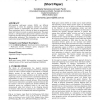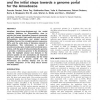954 search results - page 25 / 191 » Principles and Models for Organizing the IT Function |
ATAL
2008
Springer
13 years 9 months ago
2008
Springer
Self-organizing multi-agent systems (MAS) use different mechanisms to mimic the adaptation exhibited by complex systems situated in unpredictable and dynamic environments. These m...
NN
2008
Springer
13 years 7 months ago
2008
Springer
Currently, there is a lack of general-purpose in-place learning networks that model feature layers in the cortex. By "general-purpose" we mean a general yet adaptive hig...
IPPS
2006
IEEE
14 years 1 months ago
2006
IEEE
Bulk Synchronous Parallel ML (BSML) is an extension of the functional language Objective Caml to program Bulk Synchronous Parallel (BSP) algorithms. It is deterministic, deadlock ...
NAR
2011
12 years 10 months ago
2011
dictyBase (http://www.dictybase.org), the model organism database for Dictyostelium, aims to provide the broad biomedical research community with well integrated, high quality dat...
AGI
2011
12 years 11 months ago
2011
Extraordinary structural organization known as emergence is observed in partially ordered sets when a recently discovered functional is minimized. Emergence creates the first stru...


